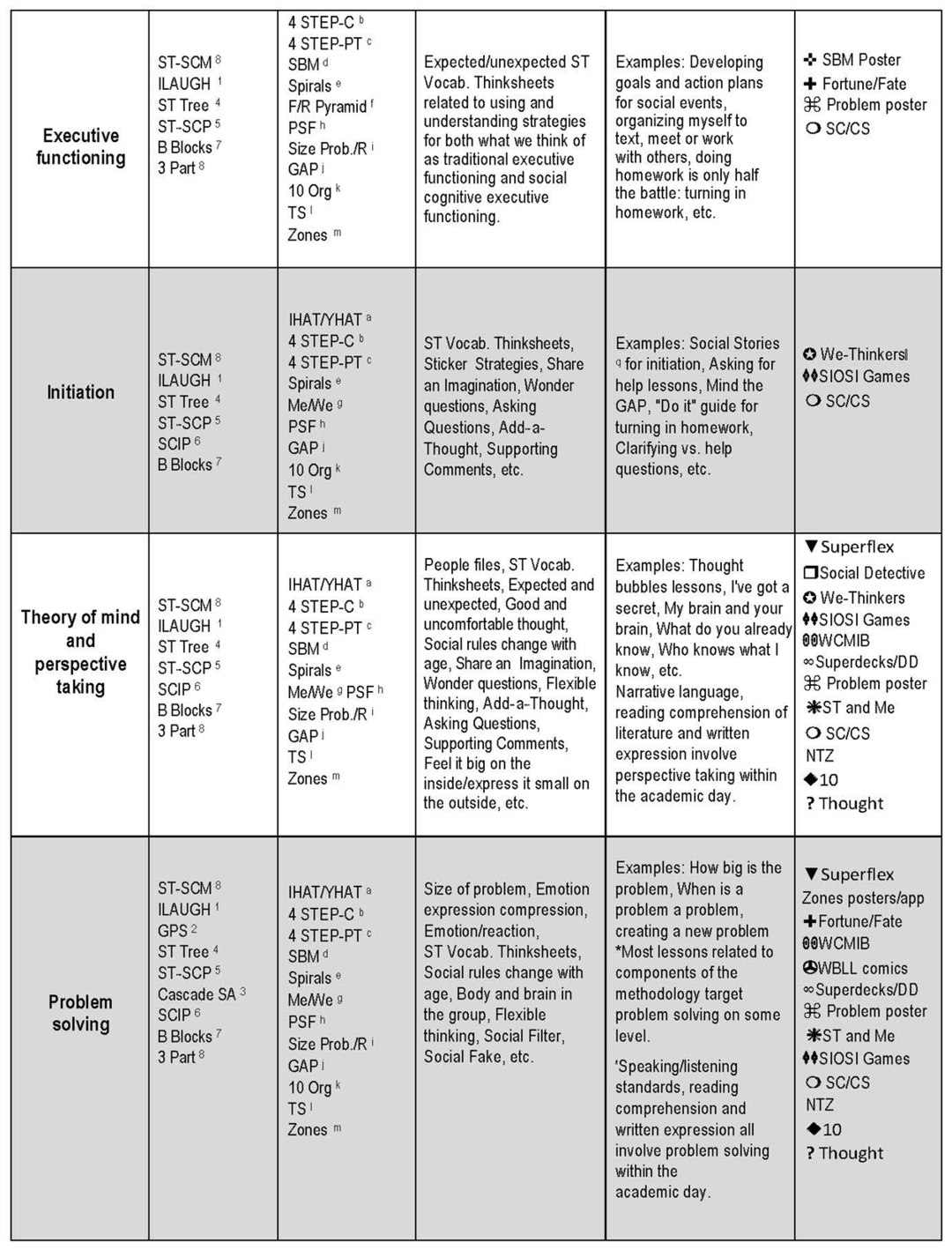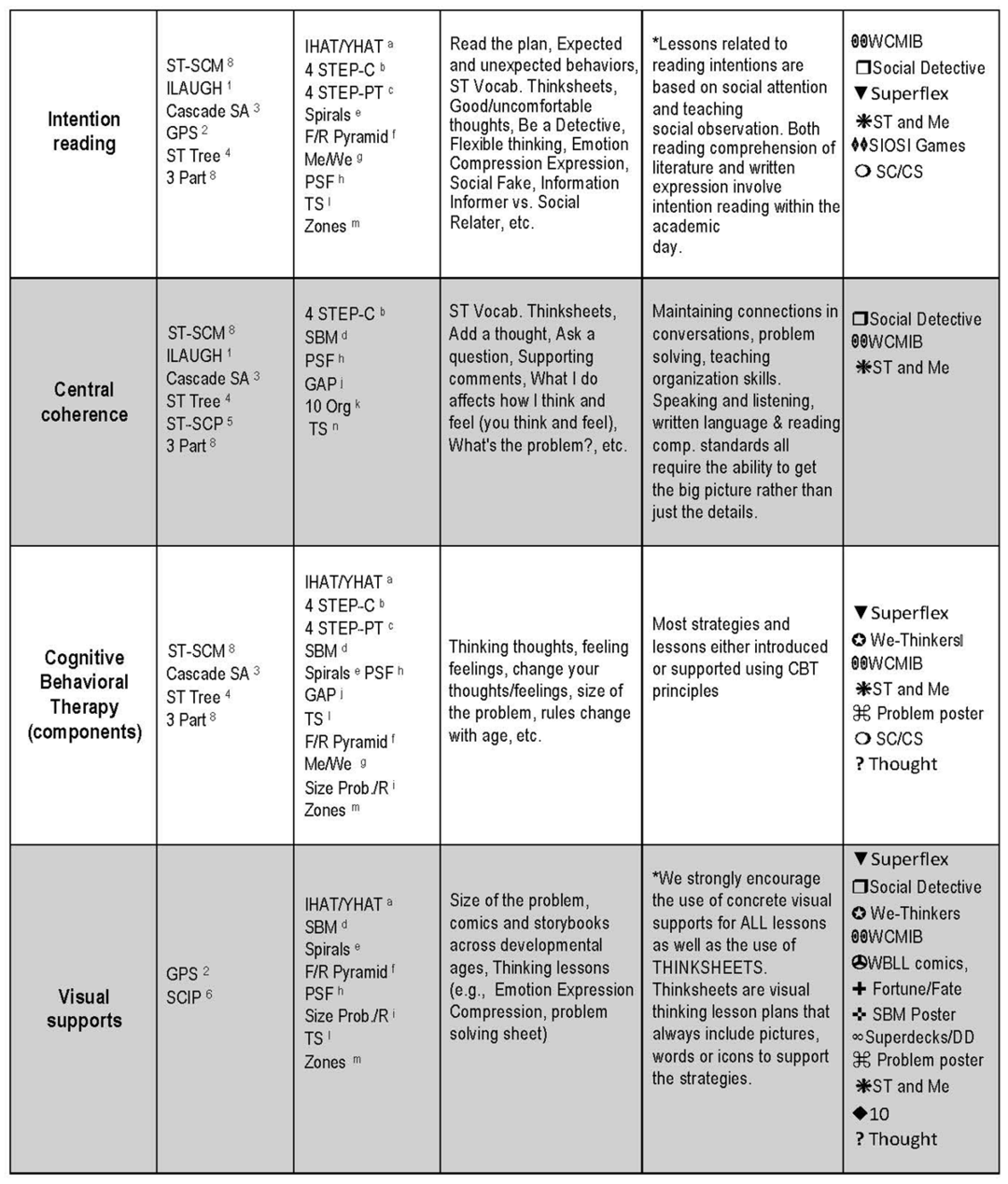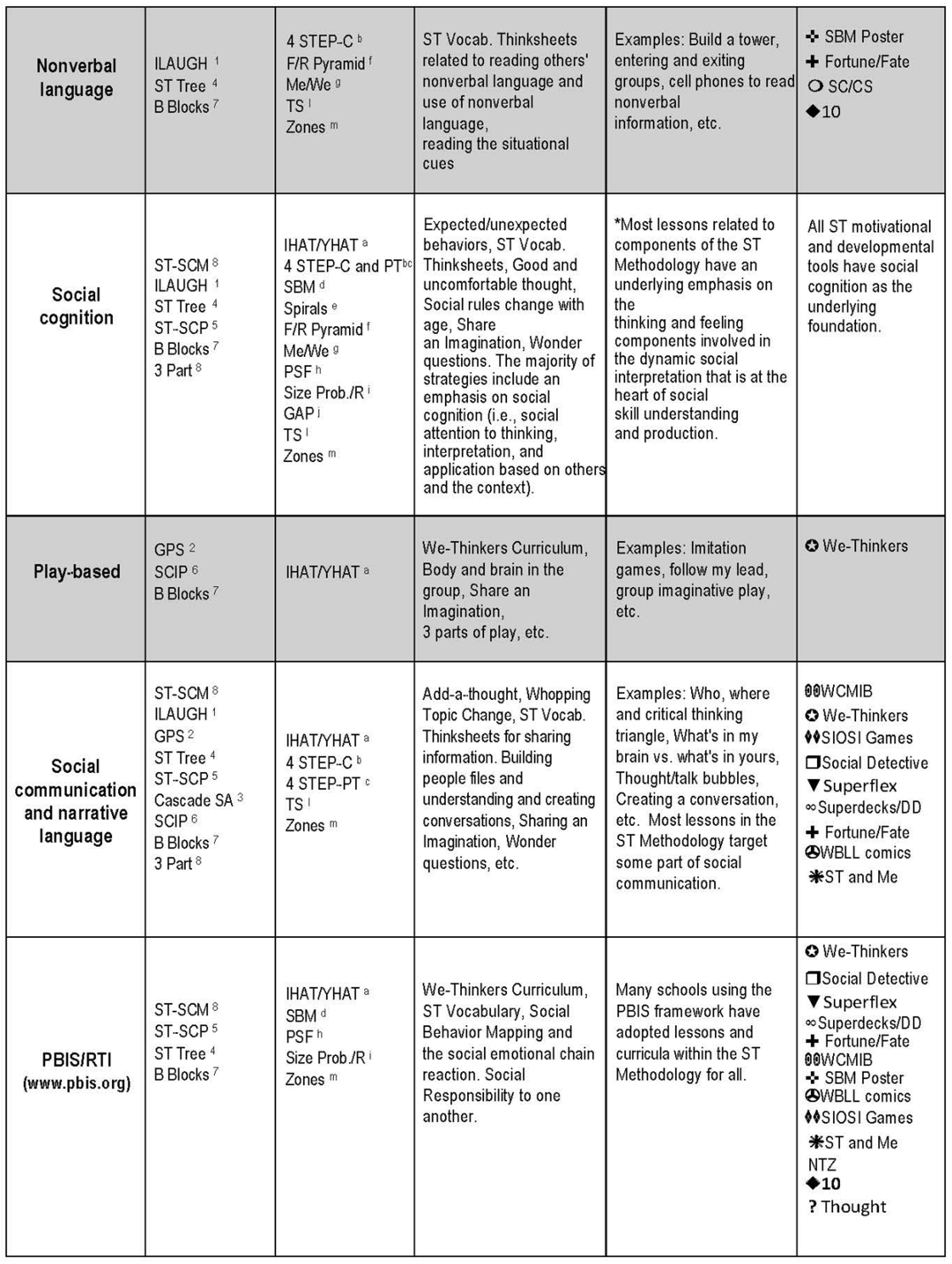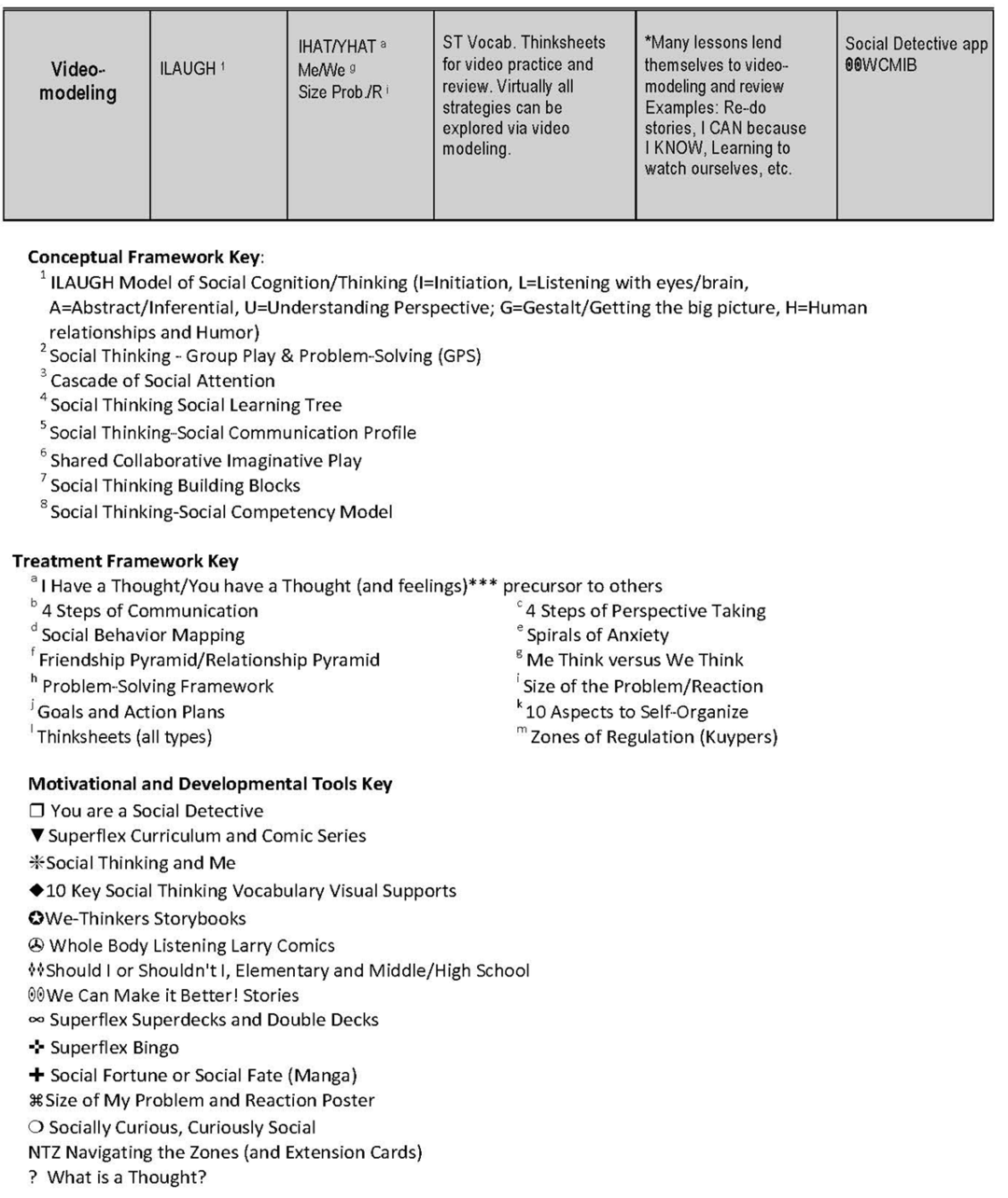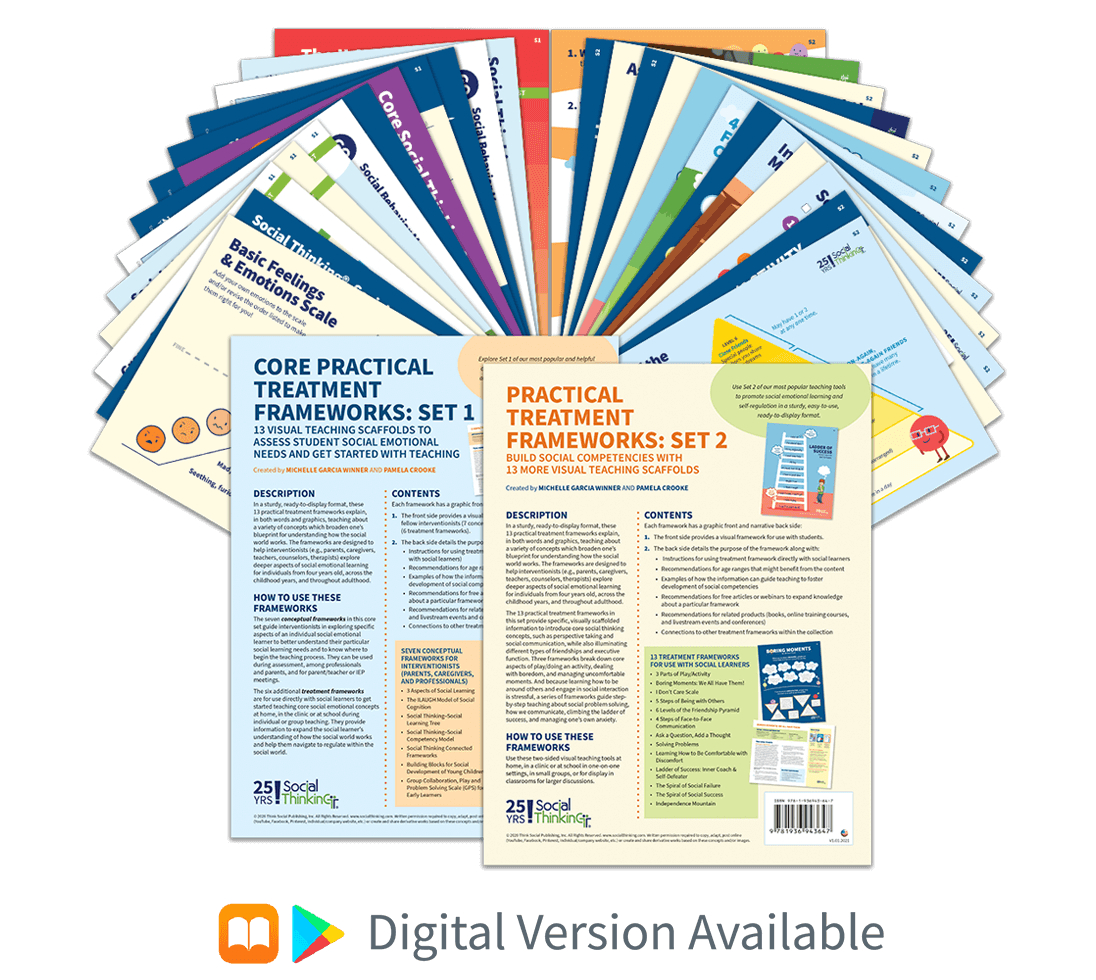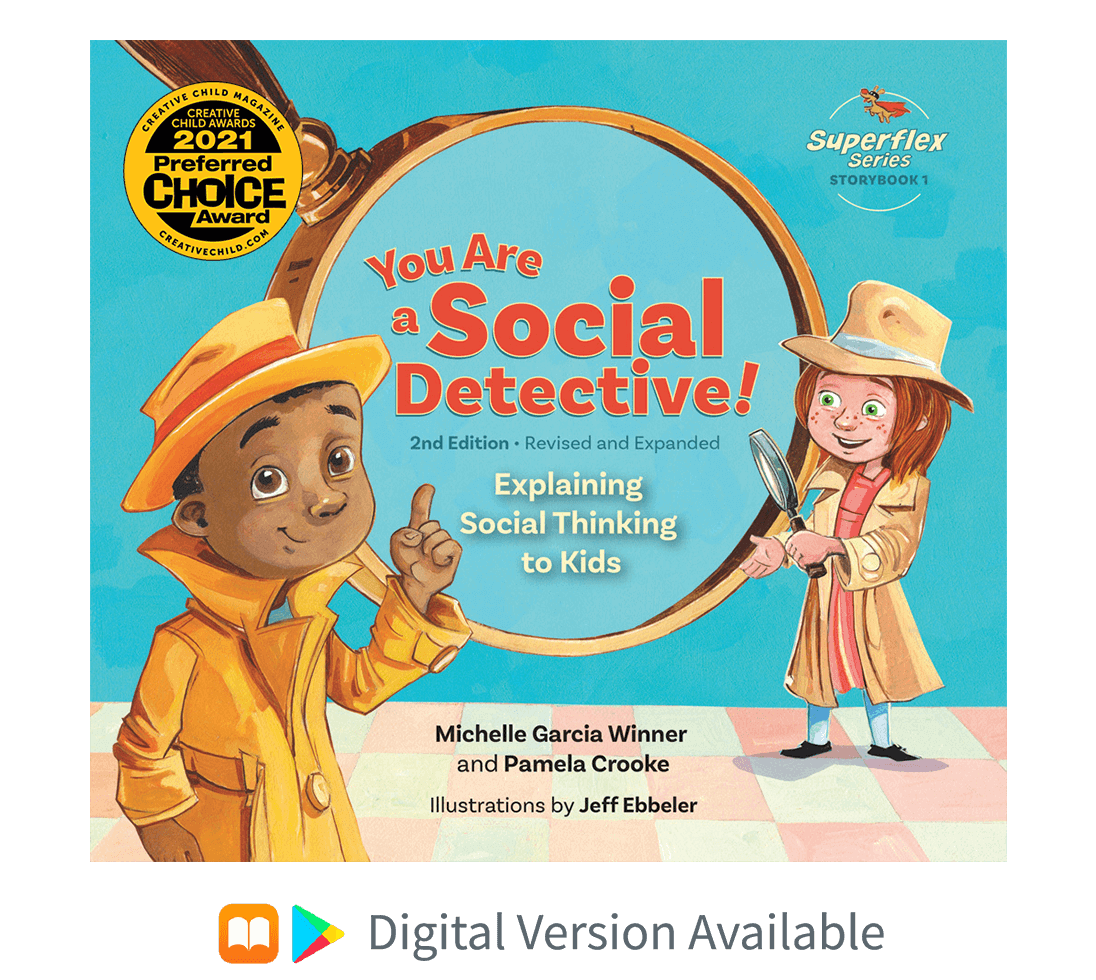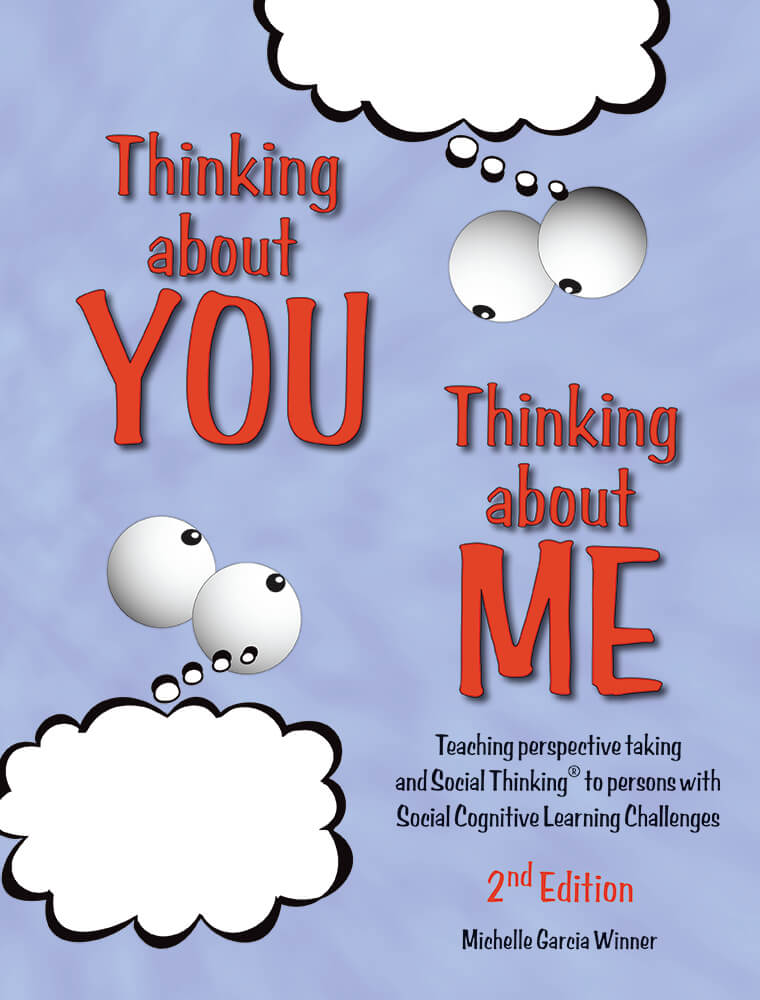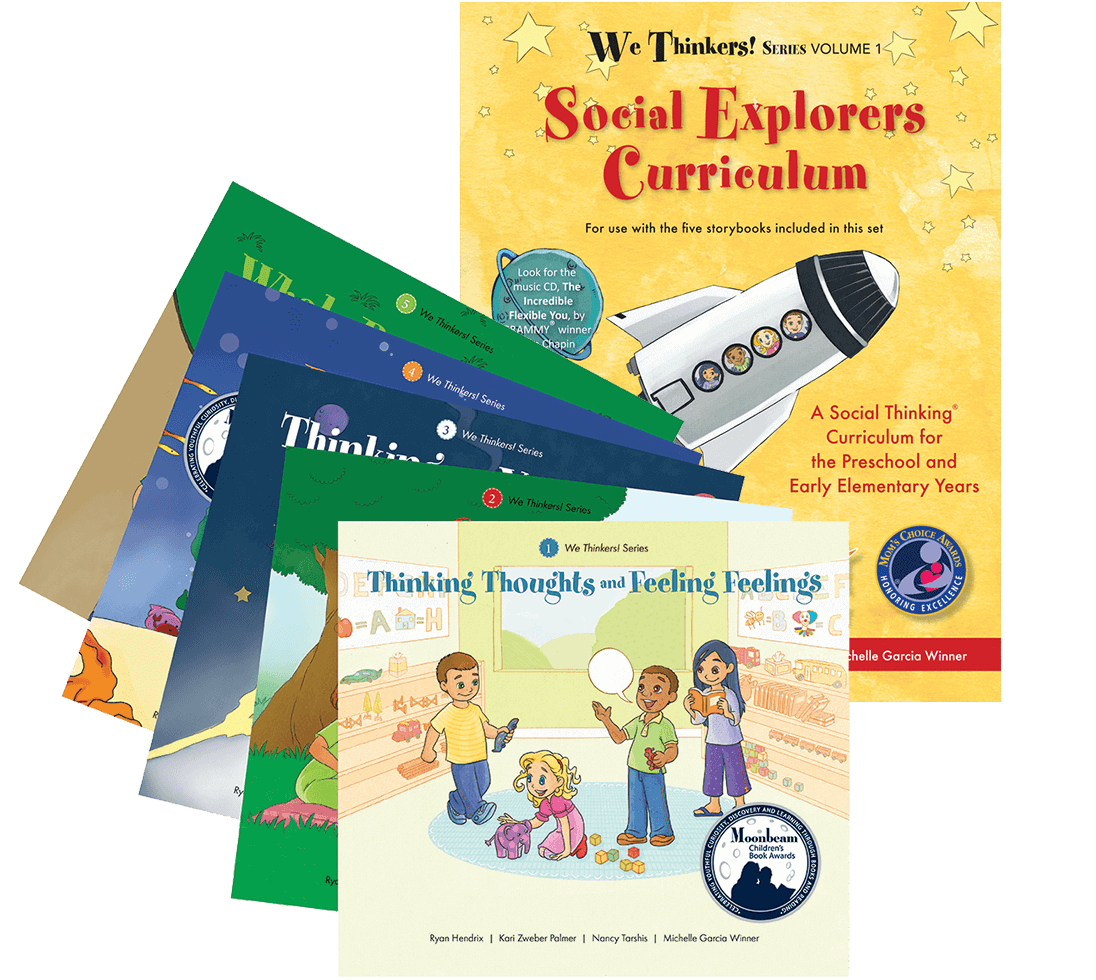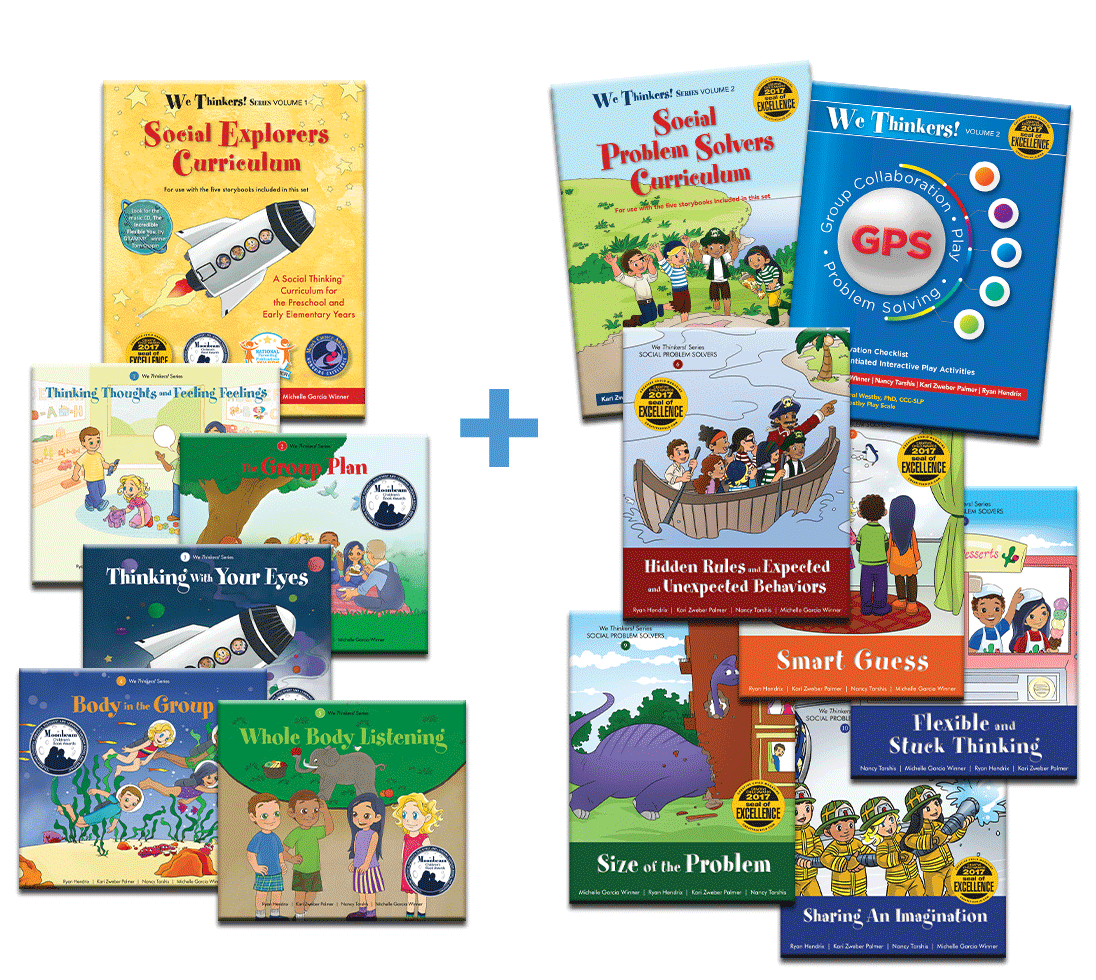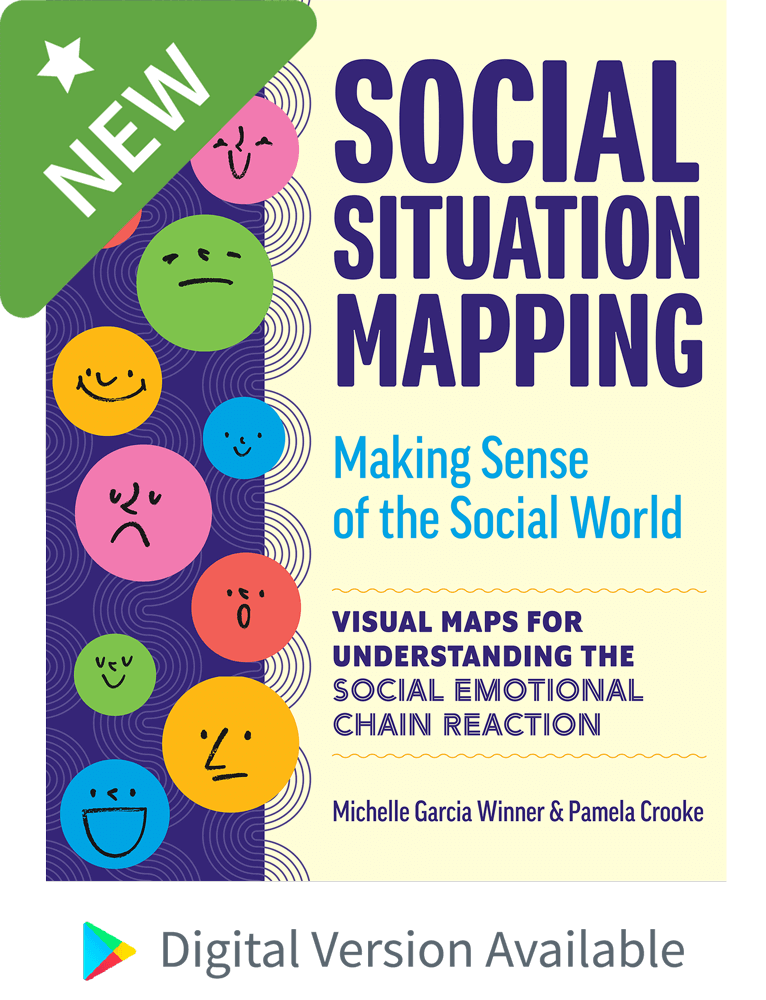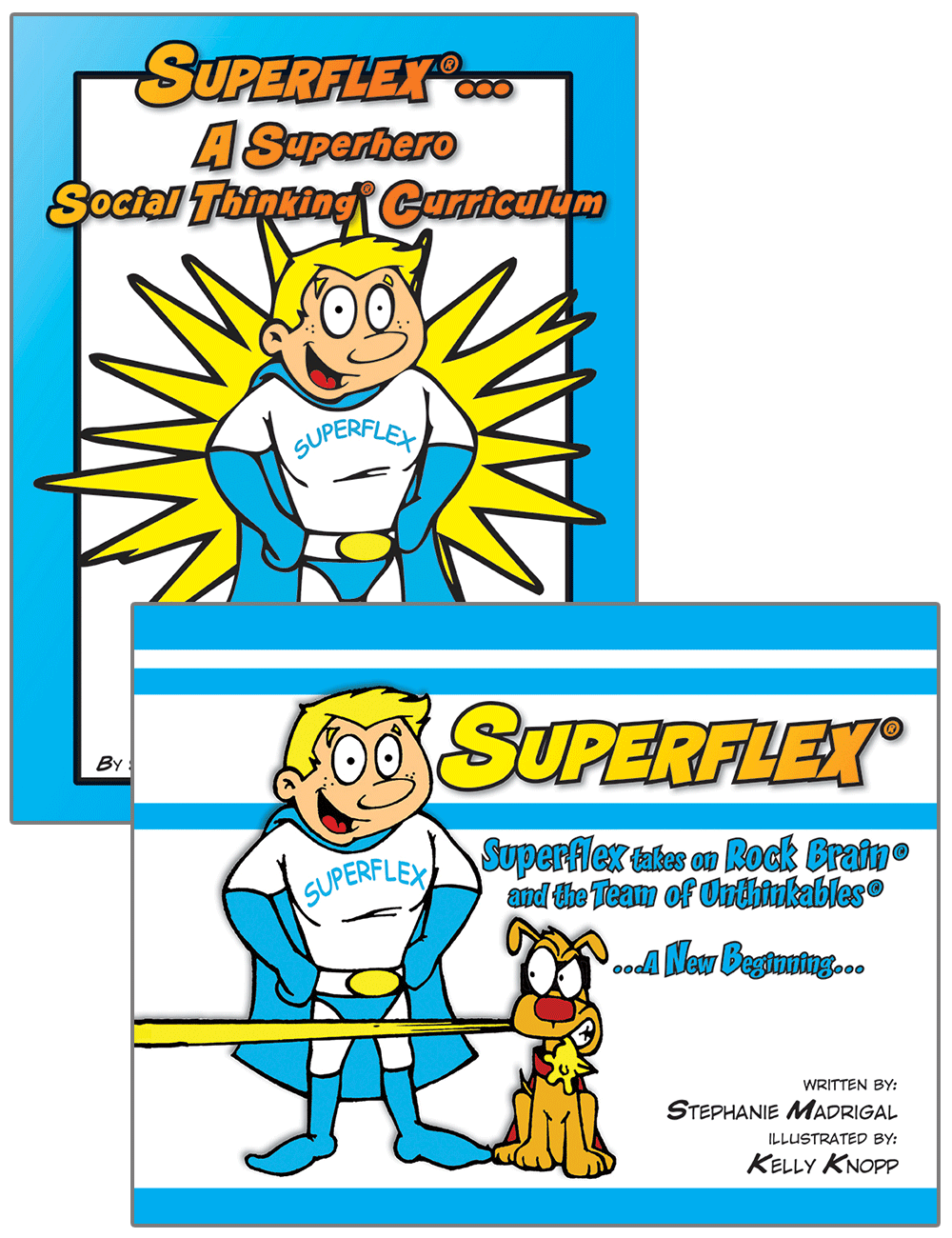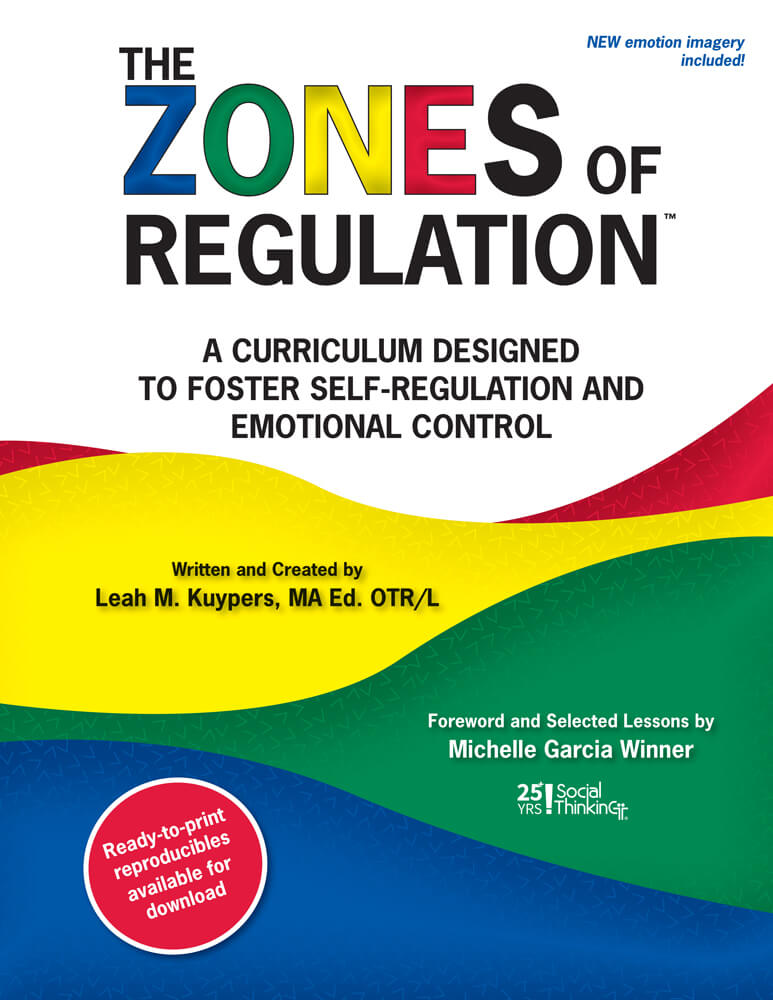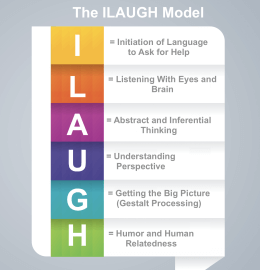Written by: Dr. Pamela Crooke, PhD, CCC-SLP, and Michelle Garcia Winner, MA, CCC-SLP
© 2021 Think Social Publishing, Inc.
I'm Doing Social Thinking® - But Where Is the Evidence? To answer the question about evidence and Social Thinking, we need to first begin with a common language and a shared understanding of terms. Right out of the gate, it’s confusing when people say they are "doing" Social Thinking because Social Thinking is not a single entity. It is not a set of behaviors that you teach. It is not a step-by-step “cookbook”, nor is it one single program or approach. Social Thinking is a language and cognitive-based methodology that focuses on the dynamic and synergistic nature of social observation, social interpretation, social problem solving, and social communication skills, all of which require self-regulation. The methodology is developmental, utilizing aspects of cognitive behavioral and behavioral principles, as well as stakeholder input as a way to translate evidence-based concepts into conceptual frameworks, strategy-based frameworks, curricula, activities, and motivational tools. (Note: a more detailed explanation of this very long sentence and a table to illustrate will follow).
Many of the components of the Social Thinking Methodology were originally developed to serve as an intervention and assessment framework for individuals with social learning challenges or what we will refer to as social learners. At its inception 25 years ago, there were relatively few treatment-based research studies available to guide interventionists in how to teach individuals about their own social learning process. The underlying motivation for the creation of the Social Thinking Methodology was, and is, that social learners with unique challenges should have access to interventions and strategies based on both individual learning abilities and the demands of the community within which they participate. Clearly, none of us would deny that individuals have varied social learning abilities and part of our mission is to create intervention strategies that span this diversity. This includes assessment of real-time social competencies, understanding different levels of the social mind, targeting social competencies over simply teaching social skills, creating holistic treatments for understanding perspective taking, social communication, self-regulation, and social anxiety, just to name a few.
A Methodology to Infuse Evidence-Based Practices
The Social Thinking Methodology embraces what the literature tells us about working directly with individuals who have social learning challenges (e.g., ASD, Social Communication Disorder, ADHD, Learning Disabilities, Twice Exceptional, etc.) and promotes the use of visual supports, modeling, naturalistic teaching, and self-management. Also, the methodology anchors to the research in fields that study how individuals evolve and develop to function in society: anthropology, cultural linguistics, social psychology, and child development. Many components fit well into the multi-tiered research-based implementation framework of Positive Behavioral Intervention and Supports (PBIS). And while PBIS is not an approach, it is a framework that encourages schools to consider the uptake of a variety of practices where the "mutually beneficial relationship between academic and social behavior student success is highlighted (Chard, Harn, Sugai, & Horner, 2008; Sugai, Horner, & Gresham, 2002). In the same vein, CASEL's five Social and Emotional Learning (SEL) Core Competencies are reflected within and throughout the Social Thinking Methodology.
"...A methodology does not set out to provide solutions—it is, therefore, not the same as a method. Instead, a methodology offers the theoretical underpinning for understanding, which method, set of methods, or so-called “best practices” can be applied to a specific case..." (https://en.wikipedia.org/wiki/Methodology)
If we aren't doing Social Thinking, then how do we talk about it?
As you can see by the diverse components of the methodology, it's not enough to say that you are "doing” Social Thinking. The reality is that most of us are implementing one (or many) components of the larger methodology. As a community, we need to articulate WHICH component we are implementing and how that component connects to the deeper layer of evidence supports.
For instance, consider stating the following rather than saying, “I’m doing social thinking”:
- Our school is implementing Superflex® or Zones of Regulation® as part of our PBIS adoption.
- We are using the We-Thinkers® curriculum within the SEL framework. It addresses joint attention, self-regulation, and perspective taking through stories and play.
- I'm teaching Social Thinking Vocabulary™ as a way to connect to the social and academic components of the Common Core/State Standards
- Our classroom is implementing Social Behavior Mapping™ for teaching social responsibility via visual supports and modeling.
- I'm teaching about the Unthinkables™ and Thinkables™ to help my students learn perspective taking and self-regulation.
Is there evidence for Social Thinking? If so, where is it?
To drill down on the evidence question, we first need to clear up a common confusion between the name of the methodology (Social Thinking) and the act of teaching individuals to think socially or use the social thinking process (i.e., socially think about the context, people, thoughts, emotions and social behaviors). We typically differentiate by referring to the methodology with capital letters (Social Thinking) versus the process of teaching how to think socially with lowercase letters (social thinking). Now, on to the evidence supporting the components of the methodology.
There are currently a handful of peer-reviewed studies, including one randomized controlled study, several theses/dissertations, and numerous articles, papers and presentations related to various components of the Social Thinking Methodology (see the Evidence tab on our website). These studies or articles represent smaller pieces of the larger methodology. Unfortunately, some studies did not use the common name of our curricula or product in the title of their paper (e.g., Superflex, Zones, We-Thinkers, Social Behavior Mapping). For example, a study title might state “cognitive intervention” or “social strategy” but the content of the study used our strategies, tools or frameworks. This makes it challenging when searching for evidence. People tend to type evidence for social thinking into a search box which may or may not located actual research related to the Social Thinking Methodology. We do our best to stay on top of studies that are published in peer-reviewed journals. Check the evidence section often to see new research related to our work.
We have found that people tend to have differing views on the term “evidence" depending upon: a) the question one asks, b) the lens with which one views the information, and c) each person’s definition of evidence. For example, the American Speech-Language-Hearing-Association (ASHA) defines evidence-based practices (EBP) as:
"The integration of: (a) clinical expertise/expert opinion, (b) external scientific evidence, and (c) client/patient/caregiver perspectives to provide high-‐quality services reflecting the interests, values, needs, and choices of the individuals we serve."
(https://www.asha.org/CE/for-providers/Evidence-Based-Practice-CE-Providers/)
ASHA further states,
"Because EBP is client/patient/family-centered, a clinician's task is to interpret best current evidence from systematic research in relation to an individual client/patient, including that individual's preferences, environment, culture, and values regarding health and well-being."
This three-pronged definition (i.e., expertise, evidence and stakeholder input) is the most common; ascribed to by numerous organizations within the behavioral, education and social sciences. We think it is important for people to understand what one means by the term “evidence” because some professions or groups define evidence based purely on research studies. This is a distinction that tends to put people into two different camps: Those who include expertise, evidence and stakeholder input as their definition of EBP and those use research studies alone as their definition of EBP.
So, the ST methodology encourages:
- Professionals to value their own professional expertise—combined with client data—to select and justify the various interventions and strategies they choose based on individual client needs, not diagnosis.
- Professionals to truly value parent input, as well as feedback from individual clients—not as an afterthought but as a part of the intervention process. After all, this is part of the definition of evidence-based practices.
- Professionals and parents to use a different lens to examine the value of data-driven interventions that are grounded in research-based theoretical concepts as well. In other words, practices based on the evidence (PBE).
National Professional Development Center (NPDC): Evidence-Based Practices and Autism
Note: While the Social Thinking Methodology is not specific to the autism spectrum, many who are a part of this community have embraced our work.
In 2014, the National Professional Development Center published findings related to evidence-based practices for individuals on the autism spectrum. This review embraced the three-prong definition of evidence-based practices, but also cautioned professionals and families to include not only published research, but also to value stakeholder input and professional expertise. Unfortunately, studies related to the ST methodology were underrepresented because of the challenges mentioned earlier (i.e., the words “social thinking” were not in the title of the study, but some components have been included in peer-reviewed studies). In fact, many of the EBPs noted in the NPDC are the foundation or infused within the Social Thinking Methodology. These include: Cognitive Behavioral Interventions, Modeling, Naturalistic Intervention, Peer-mediated intervention, Self-management, Social Skills Training, Social Narratives, Reinforcement, and Visual Supports.
Social Thinking® Methodology: More than teaching social skills
Consider this: Many interventionists implement social skill interventions without a clear definition of social skills and their importance in the holistic social relatedness process. The Social Thinking Methodology addresses the fact that first we, as interventionists (both professionals and parents), need to build our own knowledge about the social learning process and what it means to engage “socially” before teaching social learners. We call this understanding how the social world works. Remarkably, understanding how people share space together and engage across context, culture and varying ideas and opinions, motives and intentions is absent from most social "skills-based” approaches. Our methodology ascribes to the notion that the key to understanding our clients/students’ individual social learning needs requires that interventionists gain insight into the variables that contribute to their own “social self” as well as the related expectations of others. This unique view toward social treatment, combined with the many layers of our methodology, means that the components of Social Thinking do not fit neatly into any single traditionally defined social skill intervention. Nor is Social Thinking linked to a specific diagnosis (e.g., ASD), but rather addresses specific needs in those with social learning challenges (ADHD, Mental Health Challenges, twice exceptional, gifted, no diagnosis, etc.).
To illustrate, the Social Thinking Methodology (capital S and capital T) ascribes to the principles that the process of thinking socially or social thinking (small s and small t) is required to interpret (and possibly respond) to socially based information. This includes the ability to consider our own and others’ thoughts, emotions, beliefs, intentions, knowledge, etc. for interpretation (in our own mind) and related responses (through our social behavioral interactions). In the literature, this is often referred to as Social Cognition.
Social skills are the result of considering our own social thinking (social cognitive abilities) and then adapting our behavior effectively (self and social regulation), based on the situation and what we know about the people in the situation. We adapt our skills so that others will react and respond to us in the manner we had hoped. Note: not all social skill adaptations are meant to have others respond in a "polite" or kind manner. In fact, good social skills also include the ability to advocate for oneself, avoid confrontation, and enhance safety. And, the reason we use social skills is to impact how people feel, which also impacts how we feel about ourselves.
Furthermore, social learning is embedded in academic learning, which means social thinking is embedded in academic learning. One’s interpretation of the social world impacts one’s ability to engage in socially based academics such as reading comprehension of literature, written expression, and collaboration/cooperation/conversations in the classroom. Socially-based academic concepts are embedded in the educational standards on a national, provincial and state level.
It is fair to say that the social learning treatment is far more complex than most realize. However, it is through this more complex lens that the Social Thinking Methodology continues to evolve.
Social Thinking Methodology: A deeper look at the evidence base underlying the practice
The following pages illustrate a structured way to show how the Social Thinking Methodology is grounded in theoretical research-based concepts and constructs, and how each lesson and activity can be traced back to its roots in the research literature. It is also a way to make sense of the many different pathways of information we have created over time.
Column 1 (Layer 1): Theoretical concepts, constructs, and therapies (i.e., definitively recognized in the literature and possess an extensive research base). These form the foundation of all components of the methodology. Note: This column is all about what an INTERVENTIONIST (educators, therapists, and parents/caregivers) needs to understand to teach the content in columns 3, 4, 5 and 6. Theoretical concepts and constructs are not traditionally tools for teaching SOCIAL LEARNERS. *Exception: some sophisticated adults may benefit from learning about the research-base underlying the strategies.
Column 2 (Layer 2): Conceptual frameworks found within the Social Thinking Methodology that spring from, and are supported by, the research base in Layer 1. Note: This layer is about what an INTERVENTIONIST needs to understand to teach SOCIAL LEARNERS in columns 3, 4, 5 and 6. These conceptual frameworks are guideposts for the interventionist to learn how the social world works to create and organize his or her own thinking about the process of social learning and social relatedness. Conceptual frameworks are not intended for direct use with clients/students. *Exception: some sophisticated adults may benefit from understanding and learning about the conceptual frameworks underlying the strategies.
Column 3 (Layer 3): Some key treatment frameworks. Every treatment framework has a link to a conceptual framework. These treatment frameworks serve two missions: 1) Provide the INTERVENTIONIST with a deeper understanding of how the social world works, and 2) Create a structure for SOCIAL LEARNERS to understand that strategies do not stand alone but are part of a larger social process. Note: Treatment frameworks were designed for INTERVENTIONISTS to understand first and then utilize that knowledge to structure teaching for SOCIAL LEARNERS.
Column 4 (Layer 4): Intervention strategies related to the treatment frameworks. There are numerous strategies, but for the purposes of this paper and space, only Social Thinking Vocabulary (STV) and a handful of other strategies created by others are included. Note: Strategies were designed to further build the knowledge of INTERVENTIONISTS while also providing a structure for teaching SOCIAL LEARNERS.
Column 5 (Layer 5): Activities based on the treatment and conceptual frameworks. Note: Activities represent how we make the other columns come alive and are to be adapted to create meaningful lessons for SOCIAL LEARNERS.
Column 6 (Layer 6): Motivational/Developmental Tools—the ways in which we "package" the theoretical concepts/constructs, frameworks, and strategies for dissemination and implementation for teaching SOCIAL LEARNERS.
NOTE: The following table helps to show the research-based foundation of the Social Thinking Methodology and is not meant to show a 1:1 correlation between each column from left to right. The reality is that the social learning process is dynamic and synergistic, and many of the frameworks (both conceptual and treatment) overlap with a variety of research-based concepts, constructs, and therapies. In other words, use this table as a resource to help you understand the origins and connections to the literature within the lessons and activities you teach. To be clear, the pathways demonstrated in this table are NOT as unidirectional and linear as they appear—it's just not that simple. There is tremendous overlap, which makes sense! We have over-simplified the information to simply demonstrate theoretical research-based pathways. Nor is the table comprehensive by any means! Our hope is that these examples will guide your thinking, discussions with others, and ultimately your understanding of the deeper roots of the Social Thinking Methodology.
We hope this paper helps you think in a more complex manner about the strategies and activities you teach. We also hope this information prompts you to have deeper conversations with colleagues, parents, and administrators about the core evidence base underlying and EBP infused within the Social Thinking Methodology.
For more information related to evidence and the Social Thinking Methodology, click here.
Chard, D., Harn, B., Sugai, G., & Horner, R. (2008). Core features of multi‐tier systems of academic and behavioral support. In Greenwood, C. G. (Ed.), Elementary School-Wide Prevention Models: Real Models and Real Lessons Learned. New York: Guilford.
Wong, C., Odom, S. L., Hume, K., Cox, A. W., Fettig, A., Kucharczyk, S., Brock, M., Plavnick, J., Fleury, V., & Schultz, T. R. (2014). Evidence-based practices for children, youth, and young adults with Autism Spectrum Disorder. Chapel Hill: The University of North Carolina, Frank Porter Graham Child Development Institute, Autism Evidence-Based Practice Review Group.
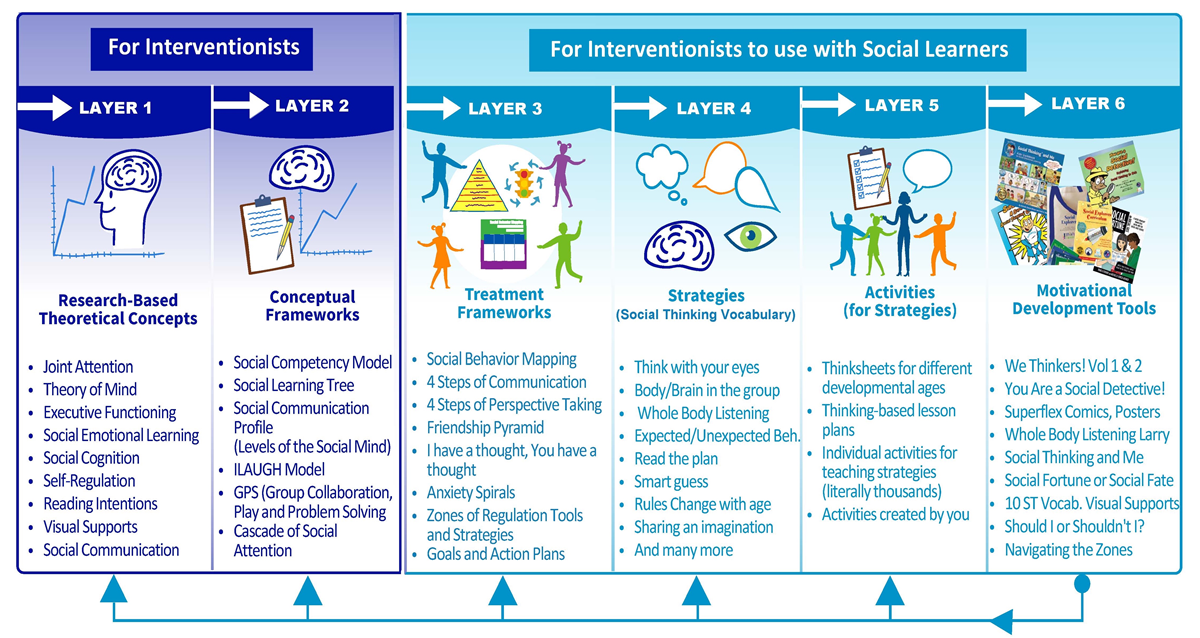
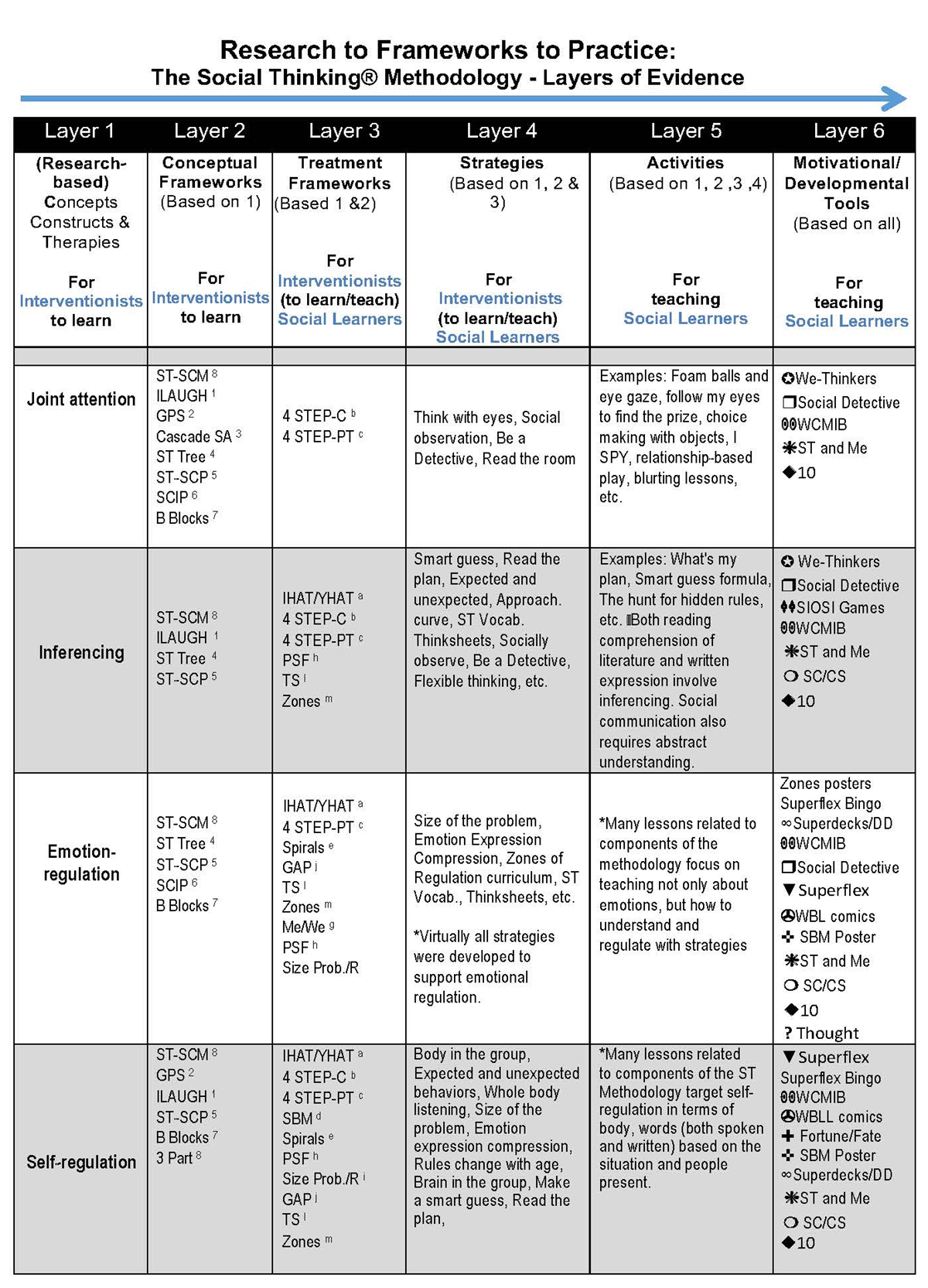
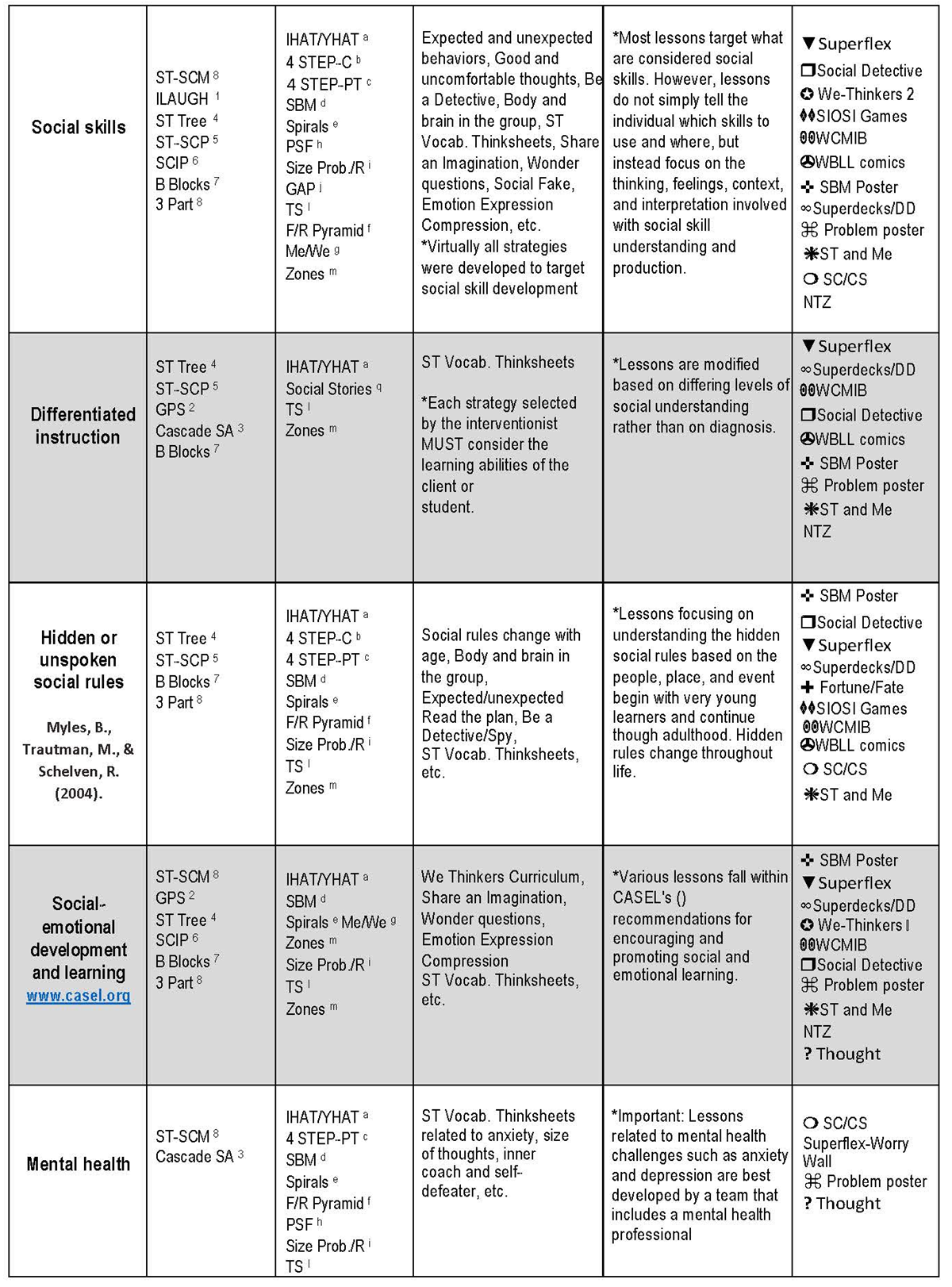
Abbreviated Bibliography
Foundational evidence and support for the Social Thinking Methodology
Adolphs, R. (2001). The neurobiology of social cognition. Current Opinion in Neurobiology, 11(2), 231-239.
Aljunied, M., & Frederickson, N. (2013). Does central coherence relate to the cognitive performance of children with autism in dynamic assessments? Autism, 17(2), 172-183.
Andrade, B. F., Waschbusch, D. A., Doucet, A., King, S., MacKinnon, M., McGrath, P. J., et al. (2012). Social information processing of positive and negative hypothetical events in children with ADHD and conduct problems and controls. Journal of Attention Disorders, 16(6), 491–504.
Austin, G., Groppe, K., & Elsner, B. (2014). The reciprocal relationship between executive function and theory of mind in middle childhood: A 1-year longitudinal perspective. Frontiers in Psychology, 5, 655. doi:10.3389/fpsyg.2014.00655
Baez, S., & Agustin, I. (2014). The effects of context processing on social cognition impairments in adults with Asperger’s syndrome. Frontiers in Neuroscience, 8. doi:10.3389/fnins.2014.00270/full
Baker-Ericzén, M. J., Fitch, M. A., Kinnear, M., Jenkins, M. M., Twamley, E. W., Smith, L., . . . Leon, J. (2017). Development of the supported employment, comprehensive cognitive enhancement, and social skills program for adults on the autism spectrum: Results of initial study. Autism. doi:10.1177/1362361317724294
Bandura, A. (1977). Social learning theory (Prentice-hall series in social learning theory). Englewood Cliffs, N.J.: Prentice Hall.
Barkley, R. A. (2004). Adolescents with attention-deficit/hyperactivity disorder: An overview of empirically based treatments. Journal of Psychiatric Practice, 10(1), 39-56.
Barry, T. D., Klinger, L. G., Lee, J. M., Palardy, N., Gilmore, T., & Bodin, S. D. (2003). Examining the effectiveness of an outpatient clinic-based social skills group for high-functioning children with autism. Journal of Autism and Developmental Disorders, 33(6), 685-701.
Baron-Cohen, S. (2000). Theory of mind and autism: A fifteen-year review. In S. Baron-Cohen, H. Tager-Flusberg, & D. Cohen (Eds.), Understanding other minds: Perspectives from develop-mental cognitive neuroscience (2nd ed., pp. 3–20). New York, NY: Oxford University Press.
Bauminger, N. (2002). The facilitation of social-emotional understanding and social interaction in high-functioning children with autism: Intervention outcomes. Journal of Autism and Developmental Disorders, 32(4), 283-298.
Bauminger, N. (2007). Brief report: Group social-multimodal intervention for HFASD. Journal of Autism and Developmental Disorders, 37(8), 1605–1615.
Beaumont, R., Rotolone, C., & Sofronoff, K. (2015). The secret agent society social skills program for children with high-functioning autism spectrum disorders: a comparison of two school variants. Psychology in the Schools, 52(4), 390–402.
Blyth, D., Olson, B., & Walker, K. (2015). Ways of Being: A Model for Social & Emotional Learning.
Bodner, K. E., Engelhardt, C. R., Minshew, N. J., & Williams, D. L. (2015). Making inferences: Comprehension of physical causality, intentionality, and emotions in discourse by high-functioning older children, adolescents, and adults with autism. Journal of autism and developmental disorders, 45(9), 2721-2733.
Bolton, J. B. (2010). Examining the effectivness of a social learning curriculum for improving social skills and self-regulation behaviors in middle school boys with autism spectrum disorder or social skill deficits (Doctoral Dissertation). PCOM Psychology Dissertations database. (14)
Brooks, R., & Meltzoff, A. N. (2015). Connecting the dots from infancy to childhood: A longitudinal study connecting gaze following, language, and explicit theory of mind. Journal of Experimental Child Psychology, 130, 67–78.
Charman, T., Carroll, F., & Sture, C. (2001). Theory of mind, executive function and social competence in boys
with ADHD. Emotional and Behavioral Difficulties,6,31–49.
Choudhury, S., Blakemore, S.-J., & Charman, T. (2006). Social cognitive development during adolescence. Social Cognitive and Affective Neuroscience, 1(3), 165-174. doi:10.1093/scan/nsl024
Choque Olsson, N., Rautio, D., Asztalos, J., Stoetzer, U., & Bölte, S. (2016). Social skills group training in high-functioning autism: A qualitative responder study. Autism, 20(8), 995-1010.
Clavenna-Deane, B. A. (2010). Using a social communication intervention to improve the social interactions and employment experiences of adolescents with high functioning autism spectrum disorders (Doctoral Dissertation). ProQuest Dissertations & Theses Global: The Humanities and Social Sciences Collection database. (748816155)
Corden, B., Chilvers, R., & Skuse, D. (2008). Emotional Modulation of Perception in Asperger’s Syndrome. Journal of Autism & Developmental Disorders, 38(6), 1072–1080. https://doi.org/10.1007/s10803-007-0485-y
Cox, A., & AFIRM Team. (2018). Video modeling. Chapel Hill, NC: National Professional Development Center on Autism Spectrum Disorder, FPG Child Development Center, University of North Carolina. Retrieved from http://afirm.fpg.unc.edu/ video-modeling
Crooke, P. J., Hendrix, R. E., & Rachman, J. Y. (2008). Brief report: Measuring the effectiveness of teaching social thinking to children with Asperger syndrome (AS) and high functioning autism (HFA). Journal of Autism and Developmental Disorders, 38(3), 581-591.
Crooke, P. J., & Winner, M. G. (2016). Social Thinking® methodology: Evidence-based or empirically supported? A response to Leaf et al. (2016). Behavior Analysis in Practice, 9(4), 403-408. doi:10.1007/s40617-016-0151-y
Crooke, P. J., & Winner, M. G. (2017). Social Behavior Mapping: Competency and fidelity rating guidelines for administration of core elements. Unpublished manuscript in preparation.
Crooke, P. J., Winner, M. G., & Olswang, L. B. (2016). Thinking socially: Teaching social knowledge to foster social behavioral change. Topics in Language Disorders, 36(3), 284-298. doi:10.1097/TLD.0000000000000094
Dawson, G., Toth, K., Abbott, R., Osterling, J., Munson, J., Estes, A., & Liaw, J. (2004). Early social attention impairments in autism: Social orienting, joint attention, and attention to distress. Developmental
Psychology, 40, 271–283.
Dodge, K. A., & Price, J. M. (1994). On the relation between social information processing and socially competent behavior in early school-aged children. Child Development, 65(5), 1385–1897.
Ekman, E., & Hiltunen, A. J. (2015). Modified CBT using visualization for Autism Spectrum Disorder ( ASD), anxiety and avoidance behavior - a quasi-experimental open pilot study. Scandinavian Journal of Psychology, 56(6), 641–648. https://doi.org/10.1111/sjop.12255
Elliott, S. N., & Gresman, F. M. (1987). Children's Social Skills: Assessment and Classification Practices. Journal of Counseling & Development, 66(2), 96.
Freeman, S. F. N., Gulsrud, A., & Kasari, C. (2015). Brief Report: Linking Early Joint Attention and Play Abilities to Later Reports of Friendships for Children with ASD. Journal of autism and developmental disorders, 45(7), 2259-2266.
Frischen, A., Bayliss, A. P., & Tipper, S. P. (2007). Gaze cueing of attention: visual attention, social cognition, and
individual differences. Psychological Bulletin, 133(4), 694.
Frith, C. D. (2008). Social cognition. Philosophical Transactions of the Royal Society of London. Series B, Biological Sciences, 363(1499), 2033-2039. doi:10.1098 /rstb.2008.0005
Frith, C. D., & Frith, U. (2012). Mechanisms of social cognition. Annual Review of Psychology, 63, 287-313.
Gallagher, T. M. (1993). Language skill and the development of social competence in school-age children. Language, Speech and Hearing Services in Schools, 24(4), 199.
Gallese, V., Keysers, C., & Rizzolatti, G. (2004). A unifying view of the basis of social cognition. Trends Cognitive Sciences, 8(9), 396-403. doi:10.1016 /j.tics.2004.07.002
Gardner, F. (2017). First-hand perspectives on behavioral interventions for autistic people and people with other developmental disabilities. Retrieved from https://autisticadvocacy.org/wp-content/uploads/2017/05/Behavioral-Interventions-Report-Final.pdf
Gast, D. L., & Ledford, J. R. (2014). Single case research methodology application in special education and behavioral sciences. New York, NY: Routledge.
Geary, M. (2010). Social cognition with autism spectrum disorders and peer relationships. (Unpublished master’s thesis). Dominican University of California, San Rafael, CA.
Gonzalez-Gadea, M. L., Baez, S., Torralva, T., Castellason, F. X., Rattazzi, A., Bein, V., et al. (2013). Cognitive
variability in adults with ADHD and AS: disentangling the roles of executive functions and social cognition. Research in Developmental Disabilities, 34,817–830.
Green, S., & Ben-Sasson, A. (2010). Anxiety disorders and sensory over-responsivity in children with autism
spectrum disorders: Is there a causal relationship? Journal of Autism and Developmental Disorders. Published online April 10, 2010. DOI 10.1007/s10803-010-1007-x.
Gulsrud, A. C., Jahromi, L. B., & Kasari, C. (2010). The co-regulation of emotions between mothers and their children
with autism. Journal of Autism and Developmental Disorders, 40(2),
227–237.
Hamilton, J. (2014). How Play Wires Kids’ Brains For Social and Academic Success. Mind Shift.
Happe, F., & Frith, U. (2006). The weak coherence account: Detail-focused cognitive style in autism spectrum disorders. Journal of Autism and Developmental Disorders, 36(1), 5-25.
Hewitt, L. (2014). Social anxiety and pragmatics in autism spectrum disorders: Cognitive behavioral therapy and its relation to speech-language pathology. Perspectives on Language Learning and Education, 21(1), 5.
Hobson, J. A., Hobson, R. P., Cheung, Y., & Caló, S. (2015). Symbolizing as interpersonally grounded shifts in meaning: social play in children with and without autism. Journal of autism and developmental disorders, 45(1), 42-52.
Hofmann, S. G., Asnaani, A., Vonk, I. J. J., Sawyer, A. T., & Fang, A. (2012). The efficacy of cognitive behavioral therapy: A review of meta-analyses. Cognitive therapy and research, 36(5), 427-440. doi:10.1007/s10608-012-9476-1
Hughes, C.,&Leekam, S. (2004).What are the links between theory of mind and social relations? Review, reflections
and new directions for studies of typical and atypical development. Social Development, 13, 590–619.
doi:10.1111/j.1467-9507.2004.00285.x.
Hughes, C., & Devine, R. (2015). Individual differences in theory of mind from preschool to adolescence:
achievements and directions. Child Development Perspectives, 9(3), 149–153.
Hutchins, T. L., Bouyea, L. B., & Prelock, P. A. (2016a). Theory of Mind Inventory - 2. Burlington, VT: University of Vermont, Department of Communication Sciences and Disorders.
Hutchins, T. L., & Prelock, P. A. (2015). Beyond the theory of mind hypothesis: using a causal model to understand the nature and treatment of multiple deficits in autism spectrum disorder. In R. H. Bahr, & E. R. Silliman (Eds.), Routledge handbook of communication sciences and disorders (pp. 247–257). New York, Routledge: Taylor & Francis.
Hutchins, T. L., Prelock, P. A., & Bonazinga, L. (2012). Psychometric evaluation of the Theory of Mind Inventory
(ToMI): a study of typically developing children and children with autism spectrum disorder. Journal of Autism and Developmental Disorders, 42,327–341.
Hutchins, T. L., & Brien, A. (2016). Conversational topic moderates social attention in autism spectrum disorder: Talking about emotions is like driving in a snowstorm. Research in Autism Spectrum Disorders, 26, 99-110.
Hutchins, T. L., Bouyea, L. B., & Prelock, P. A. (2016a). Theory of Mind Inventory - 2. Burlington, VT: University of Vermont, Department of Communication Sciences and Disorders.
Hutchins, T. L., Prelock, P. A., Morris, H., Benner, J., LaVigne, T., & Hoza, B. (2016b). Explicit vs. applied theory of mind competence: A comparison of typically developing males, males with ASD, and males with ADHD. Research in Autism Spectrum Disorders, 21, 94-108.
Kaat, A. J., & Lecavalier, L. (2014). Review: Group-based social skills treatment: A methodological review. Research in Autism Spectrum Disorders, 8, 15-24. doi:10.1016/j.rasd.2013.10.007
Kimhi, Y. (2014). Theory of mind abilities and deficits in autism spectrum disorders. Topics in Language Disorders, 34(4), 329-343.
Koning, C., Magill-Evans, J., Volden, J., & Dick, B. (2013). Efficacy of cognitive behavior therapy-based social skills intervention for school-aged boys with autism spectrum disorders. Research in Autism Spectrum Disorders, 7, 1282-1290. doi:10.1016/j.rasd.2011.07.011
Imuta, K., Henry, J. D., Slaughter, V., Selcuk, B., & Ruffman, T. (2016). Theory of mind and prosocial behavior in childhood: A meta-analytic review. Dev Psychol, 52(8), 1192-1205.
Laurent, A. C., & Gorman, K. (2018). Development of emotion self-regulation among young children with autism
spectrum disorders: The role of parents. Journal of Autism and Developmental Disorders, 48(4), 1249–1260.
Laurent, A. C., & Rubin, E. (2004). Challenges in emotional regulation in Asperger syndrome and high-functioning
autism. Topics in Language Disorders, 24(4), 286–297.
Lee, K. Y. S., Crooke, P. J., Lui, A. L. Y., Kan, P. P. K., Mark, Y.-m., van Hasselt, C. A., & Tong, M. C. F. (2016). The outcome of a social cognitive training for mainstream adolescents with social communication deficits in a Chinese community. International Journal of Disability, Development and Education, 63(2), 201-223. doi:10.1080/1034912X.2015.1065960
Lerner, M. D., Hutchins, T. L., & Prelock, P. A. (2011). Brief report: Preliminary evaluation of the theory of mind inventory and its relationship to measures of social skills. Journal of Autism and Developmental Disorders, 41(4), 512-517.
Leung, R. C., Vogan, V. M., Powell, T. L., Anagnostou, E., & Taylor, M. J. (2016). The role of executive functions in social impairment in autism spectrum disorder. Child Neuropsychology: A Journal on Normal and Abnormal Development in Childhood and Adolescence, 22(3), 336-344. doi:10.1080/09297049.2015. 1005066
Lickel, A., MacLean, W. E., Jr., Blakeley-Smith, A., & Hepburn, S. (2012). Assessment of the prerequisite skills for cognitive behavioral therapy in children with and without autism spectrum disorders. Journal of Autism and Developmental Disorders, 42(6), 992-1000. doi:10.1007/s10803-011-1330-x
Liew, S. M., Thevaraja, N., Hong, R. Y., & Magiati, I. (2015). The relationship between autistic traits and social anxiety, worry, obsessive--compulsive, and depressive symptoms: specific and non-specific mediators in a student sample. Journal of autism and developmental disorders, 45(3), 858-872.
Mary, A., Slama, H., Mousty, P., Massat, I., Capiau, T., Drabs, V., & Peigneux, P. (2016). Executive and attentional contributions to theory of mind deficit in attention deficit/hyperactivity disorder (ADHD). Child Neuropsychology: A Journal on Normal and Abnormal Development in Childhood and Adolescence, 22(3), 345-365. doi:10.1080/09297049.2015.1012491
McEvoy, R. E., Rogers, S. J., & Pennington, B. F. (1993). Executive function and social communication deficits in young autistic children. Journal of Child Psychology and Psychiatry, 34(4), 563-578.
McGillivray, J., & Evert, H. (2011). Group Cognitive Behavioural Therapy Program Shows Potential in Reducing Symptoms of Depression and Stress Among Young People with ASD. Journal of Autism & Developmental Disorders, 41(9), 2041–2051. https://doi.org/10.1007/s10803-014-2087-9
McMahon, C. M., Lerner, M. D., & Britton, N. (2013). Group-based social skills interventions for adolescents with higher-functioning autism spectrum disorder: A review and looking to the future. Adolescent Health, Medicine and Therapeutics, 4, 23-38.
Mesibov, G. B., & Shea, V. (2010). The TEACCH program in the era of evidence-based practice. Journal of Autism
and Developmental Disorders, 40(5), 570–579.
Mesibov, G. B., Shea, V., & Schopler, E. (2005). The TEACCH approach to autism spectrum disorders. New York,
NY: Springer Science & Business Media.
Miller, S. A. (2009). Childrenʼs understanding of second-order mental states. Psychological Bulletin(5), 749. doi:10.1037/a0016854
Miniscalco, C., Hagberg, B., Kadesjo, B., Westerlund, M., & Gillberg, C. (2007). Narrative skills, cognitive
profiles and neuropsychiatric disorders in 7–8-year-old children with late developing language. International Journal of Language and Communication Disorders, 42(6), 665–681.
Miranda, A., Berenguer, C., Roselló, B., Baixauli, I., & Colomer, C. (2017). Social cognition in children with high-functioning autism spectrum disorder and attention-deficit/hyperactivity disorder. Associations with executive functions. Frontiers in Psychology, 8. doi:10.3389/fpsyg.2017.01035
Müller, E., Cannon, L. R., Kornblum, C., Clark, J., & Powers, M. (2016). Description and preliminary evaluation of a curriculum for teaching conversational skills to children with high-functioning autism and other social cognition challenges. Language, Speech, and Hearing Services in Schools, 47(3), 191-208. doi:10.1044/2016_LSHSS-15-0042
Mundy, P., & Acra, C. (2006). Joint attention, social engagement, and the development of social competence.
In P. Marshall & Fox (Eds.), The development of social neurobiological perspectives (pp. 81–117). New York, NY: Oxford University Press.
Mundy, P. C. (2016). Autism and joint attention: Development, neuroscience, and clinical fundamentals. New York:
Guilford Publications.
Mundy, P., Kim, K., McIntyre, N., Lerro, L., & Jarrold, W. (2016). Brief Report: Joint Attention and Information
Processing in Children with Higher Functioning Autism Spectrum Disorders. J Autism Dev Disord, 46(7), 2555-2560.
Murza, K. A., Schwartz, J. B., Hahs-Vaughn, D. L., & Nye, C. (2016). Joint attention interventions for children with
autism spectrum disorder: a systematic review and meta-analysis. International Journal of Language & Communication Disorders, 51(3), 236–251.
Myles, B. S., & Simpson, R. L. (2001). Understanding the Hidden Curriculum: An Essential Social Skill for Children and Youth with Asperger Syndrome. Intervention in School & Clinic, 36(5), 279.
Lawson, R., Papadakis, A. A., Higginson, C. I., Barnett, J. E., & Willis, M. C. (2014). Everyday executive function
impairments predict comorbid psychopathology in autism spectrum and attention deficit hyperactivity disorders. Neuropsychology . http://dx.doi.org/10.1037/neu0000145.
Ozonoff, S., Pennington, B. F., & Rogers, S. J. (1991). Executive function deficits in high-functioning autistic individuals: Relationship to theory of mind. Journal of Child Psychology and Psychiatry, and Allied Disciplines, 32(7), 1081-1105.
Pavlova, M. A., Guerreschi, M., Tagliavento, L., Gitti, F., Sokolov, A. N., Fallgatter, A. J., & Fazzi, E. (2017). Social cognition in autism: Face tuning. Scientific Reports, 7(1), 2734-2734. doi:10.1038/s41598-017-02790-1
Perner, J., Kain, W., & Barchfeld, P. (2002). Executive control and higher-order theory of mind in children at risk of
ADHD. Infant and Child Development, 112, 141–158.
Papadopoulos, T. C., Panayiotou, G., Spanoudis, G., & Natsopoulos, D. (2005). Evidence of poor planning in
children with attention deficits. Journal of Abnormal Child Psychology, 33(5), 611–623.
Pellicano, E. (2010). Individual differences in executive function and central coherence predict developmental changes in theory of mind in autism. Developmental psychology, 46(2), 530.
Radley, K. C., Ford, W. B., McHugh, M. B., Dadakhodjaeva, K., OHandley, R. D., Battaglia, A. A. et al. (2015). Brief report: Use of Superheroes Social Skills to promote accurate social skill use in children with autism spectrum disorder. Journal of autism and developmental disorders, 45(9), 3048-3054.
Ratcliffe, B., Wong, M., Dossetor, D., & Hayes, S. (2015). The Association Between Social Skills and Mental Health in School-Aged Children with Autism Spectrum Disorder, With and Without Intellectual Disability. Journal of Autism & Developmental Disorders, 45(8), 2487–2496. https://doi.org/10.1007/s10803-015-2411-z
Rao, P., Beidel, D., & Murray, M. (2008). Social Skills Interventions for Children with Asperger Syndrome or High Functioning Autism: A review and recommendations. Journal of Autism and Developmental Disorders, 38, 353–361.[Article] (http://dx.doi.org/10.1007/s10803-007-0402-4) [PubMed] (http://www.ncbi.nlm.nih.gov/pubmed/17641962)
Reaven, J., Blakeley-Smith, A., Culhane-Shelburne, K., & Hepburn, S. (2012). Group cognitive behavior therapy for children with high-functioning autism spectrum disorders and anxiety: a randomized trial. Journal of Child Psychology & Psychiatry, 53(4), 410–419. https://doi.org/10.1111/j.1469-7610.2011.02486.x
Reaven, J., Blakeley-Smith, A., Nichols, S., Dasari, M., Flanigan, E., & Hepburn, S. (2009). Cognitive behavioral group treatment for anxiety symptoms in children with high functioning autism spectrum disorders: A pilot study. Focus on Autism and Other Developmental Disorders, 24(1), 27–37.
Reichow, B., & Volkmar, F. R. (2010). Social skills interventions for individuals with autism: Evaluation for evidence-based practices within a best evidence synthesis framework. Journal of Autism and Developmental Disorders, 40(2), 149-166. doi:10.1007/s10803-009-0842-0
Rotheram-Fuller, E., & MacMullen, L. (2011). Cognitive-behavioral therapy for children with autism spectrum disorders. Psychology in the Schools, 48(3), 263.
Samson, A. C., Huber, O., & Gross, J. J. (2012). Emotion regulation in Asperger’s syndrome and high-functioning autism. Emotion, 12(4), 659–665. https://doi.org/10.1037/a0027975
Sawyer, A., Williamson, P., & Young, R. (2014). Metacognitive Processes in Emotion Recognition: Are They Different in Adults with Asperger’s Disorder? Journal of Autism & Developmental Disorders, 44(6), 1373–1382. https://doi.org/10.1007/s10803-013-1999-0
Schaller, U. M., & Rauh, R. (2017). What difference does it make? Implicit, explicit and complex social cognition in autism spectrum disorders. Journal of Autism and Developmental Disorders, 47(4), 961-979.
Sibley, M. H., Kuriyan, A. B., Evans, S. W., Waxmonsky, J. G., & Smith, B. H. (2014). Pharmacological and psychosocial treatments for adolescents with ADHD: An updated systematic review of the literature. Clinical Psychology Review, 34(3), 218-232. doi:https://doi.org/10.1016/j.cpr.2014.02.001
Shteynberg, G. (2015). Shared attention. Perspectives on Psychological Science, 10(5), 579–590.
Shteynberg, G., & Apfelbaum, E. P. (2013). The Power of Shared Experience Simultaneous Observation With Similar
Others Facilitates Social Learning. Social Psychological and Personality Science, 4(6), 738–744.
Skorich, D. P., May, A. R., Talipski, L. A., Hall, M. H., Dolstra, A. J., Gash, T. B. et al. (2016). Is Social Categorization the Missing Link Between Weak Central Coherence and Mental State Inference Abilities in Autism? Preliminary Evidence from a General Population Sample. Journal of autism and developmental disorders, 46(3), 862-881.
Sofronoff, K., Attwood, T., & Hinton, S. (2005). A randomized controlled trial of a CBT intervention for anxiety in
children with Asperger syndrome. Journal of Child Psychology and Psychiatry, 46(11), 1152–1160.
Soorya, L. V., Weinger, P. M., Beck, T., Soffes, S., Halpern, D., Gorenstein, M., . . . Wang, A. T. (2015). Randomized comparative trial of a social cognitive skills group for children with autism spectrum disorder. Journal of the American Academy of Child and Adolescent Psychiatry, 54(3), 208-216. doi:10.1016/ j.jaac.2014.12.005
Spain, D., & Blainey, S. H. (2015). Group social skills interventions for adults with high-functioning autism spectrum disorders: A systematic review. Autism, 19(7), 874-886.
Stevens, T., Peng, L., & Barnard-Brak, L. (2016). The comorbidity of ADHD in children diagnosed with autism spectrum disorder. Research in Autism Spectrum Disorders, 31(Supplement C), 11-18. doi:https://doi.org/10.1016/ j.rasd.2016.07.003
Stichter, J. P., Herzog, M. J., Visovsky, K., Schmidt, C., Randolph, J., Schultz, T., & Gage, N. (2010). Social competence intervention for youth with Asperger syndrome and high-functioning autism: An initial investigation. Journal of Autism and Developmental Disorders, 40(9), 1067-1079. doi:10.1007/s10803-010-0959-1
Sugai, G., & Simonsen, B. (2012). Positive behavioral interventions and supports: History, defining features, and
misconceptions. Center for PBIS & Center for Positive Behavioral Interventions and Supports, University of Connecticut.
Taylor, C. M. A. (2011). Evaluating the effectiveness of the Social Thinking intervention to increase social responsiveness of adolescents and young adults with Asperger syndrome: A mixed methods approach (Doctoral dissertation). ProQuest Dissertations & Theses Global: The Humanities and Social Sciences Collection database. (892025785)
Thomas, L. B., Shaprio, E. S., DuPaul, J., Lutz, G., & Kern, L. (2011). Predictors of social skills for preschool children
at risk for ADHD: the relationship between direct and indirect measurements. Journal of Psychoeducational Assessment, 29(2), 114–124.
Tomasello, M. (1995). Joint attention as social cognition. In C. Moore & P. Dunham (Eds.), Joint attention: Its
origins and role in development (pp. 103–130). New York, NY: Psychology Press.
Tse, J., Strulovitch, J., Tagalakis, V., Meng, L., & Fombonne, E. (2007). Social skills training for adolescents with Asperger syndrome and high-functioning autism. Journal of Autism and Developmental Disorders, 37(10), 1960-1968.
van Kleeck, A., Vander Woude, J., & Hammett, L. (2006). Fostering literal and inferential language skills in
Head Start pre- schoolers with language impairment using scripted book-sharing discussions. American Journal of Speech-Language Pathology, 15, 85–95.
Vermeulen, P. (2015). Context blindness in autism spectrum disorder: Not using the forest to see the trees as trees. Focus on Autism and Other Developmental Disabilities, 30(3), 182-192. doi:10.1177/1088357614528799
Vidal, R., Castells, J., Richarte, V., Palomar, G., García, M., Nicolau, R., . . . Ramos-Quiroga, J. A. (2015). Group therapy for adolescents with attention-deficit/hyperactivity disorder: A randomized controlled trial. Journal of the American Academy of Child and Adolescent Psychiatry, 54(4), 275-282. doi:https://doi.org/10.1016/j.jaac.2014.12.016
Wallace, G. L., Kenworthy, L., Pugliese, C. E., Popal, H. S., White, E. I., Brodsky, E. et al. (2016). Real-world
executive functions in adults with autism spectrum disorder: Profiles of impairment and associations with adaptive functioning and co-morbid anxiety and depression. Journal of autism and developmental disorders, 46(3), 1071-1083.
Waugh, C., & Peskin, J. (2015). Improving the social skills of children with HFASD: An intervention study. Journal of autism and developmental disorders, 45(9), 2961-2980.
Weisberg, D. S., Kittredge, A. K., Hirsh-Pasek, K., Golinkoff, R. M., & Klahr, D. (2015). Making play work for education. Phi Delta Kappan, 96(8), 8-13.
Westby, C., & Robinson, L. (2014). A Developmental Perspective for Promoting Theory of Mind. Topics in Language Disorders, 34(4), 362-382.
White, S., Keonig, K., & Scahill, L. (2007). Social Skill Development in children with autism spectrum disorder: A
review of intervention research. Journal of Autism and Developmental Disorders, 37, 1858–1868. [Article] (http://dx.doi.org/10.1007/s10803-006-0320-x) [PubMed] (http://www.ncbi.nlm.nih.gov/pubmed/17195104)
White, S. W., Ollendick, T., Albano, A. M., Oswald, D., Johnson, C., Southam-Gerow, M. A., . . . Scahill, L. (2013). Randomized controlled trial: Multimodal anxiety and social skill intervention for adolescents with autism spectrum disorder. Journal of Autism and Developmental Disorders, 43(2), 382-394. doi:10.1007/ s10803-012-1577-x
White, S. W., Oswald, D., Ollendick, T., & Scahill, L. (2009). Anxiety in children and adolescents with autism
spectrum disorders. Clinical Psychology Review, 29(3), 216–229.
Williams, D., & Happé, F. (2010). Recognising 'social' and 'non-social' emotions in self and others: A study of autism. Autism: The International Journal of Research and Practice, 14(4), 285-304. doi:10.1177/1362361309344849
Winner, M. G., & Crooke, P. (2013, October). Social learning and social functioning. Attention, 26-29.
Winner, M. G., & Crooke, P. (2014). Executive functioning and social pragmatic communication skills: Exploring the threads in our social fabric. Perspectives on Language Learning and Education, 21(2), 42.
Winner, M. G., & Crooke, P. (2016). Beyond skills: The worth of social competence. ASHA Leader, 21(9), 50-56.
Winner, M. G., & Crooke, P. (2017, April 13). Social competency model: Attend-interpret-problem solve-then social
skills. Retrieved from https://www.socialthinking.com/Articles?name=social-competency-model-attend- interpret-problem-solve-respond
Winner, M. G., Crooke, P., & Madrigal, S. (2011, March 15). Communication profile: Levels of the social mind.
Retrieved from https://www.socialthinking.com/Articles?name=social-thinking-social-communication-profile
Winner, M. G., & Crooke, P. J. (2009). Social Thinking: A training paradigm for professionals and treatment approach for individuals with social learning/social pragmatic challenges. SIG 1 Perspectives on Language Learning and Education, 16(2), 62-69.
Winner, M. G., & Crooke, P. J. (2011). Social communication strategies for adolescents with autism. ASHA Leader, 16(1), 8.
Wood, J., Drahota, A., Sze, K., Van Dyke, M., Decker, K., Fujii, C., . . . Spiker, M. (2009a). Brief report: Effects of cognitive behavioral therapy on parent-reported autism symptoms in school-age children with high-functioning autism. Journal of Autism and Developmental Disorders, 39(11), 1608-1612. doi:10.1007/s10803-009-0791-7
Wood, J. J., Drahota, A., Sze, K., Har, K., Chiu, A., & Langer, D. A. (2009b). Cognitive behavioral therapy for anxiety in children with autism spectrum disorders: A randomized controlled trial. Journal of Child Psychology and Psychiatry, 50(3), 224-234. doi:10.1111/j.1469-7610.2008.01948.x
Wolfberg, P., DeWitt, M., Young, G. S., & Nguyen, T. (2015). Integrated play groups: Promoting symbolic play and social engagement with typical peers in children with ASD across settings. Journal of autism and developmental disorders, 45(3), 830-845.
Wolfberg, P. J. (2003). Peer play and the autism spectrum: the art of guiding children’s socialization and imagination.
Kansas City: AAPC Publishing.
Wyer Jr, R. S., & Srull, T. K. (2014). Handbook of Social Cognition: Volume 1: Basic Processes Volume 2: Applications. Psychology Press.
Yoon Phaik Ooi, Ze Jia Tan, Cui Xi Lim, Tze Jui Goh, & Min Sung. (2011). Prevalence of behavioural and emotional problems in children with high-functioning autism spectrum disorders. Australian & New Zealand Journal of Psychiatry, 45(5), 370–375. https://doi.org/10.3109/00048674.2010.534071





